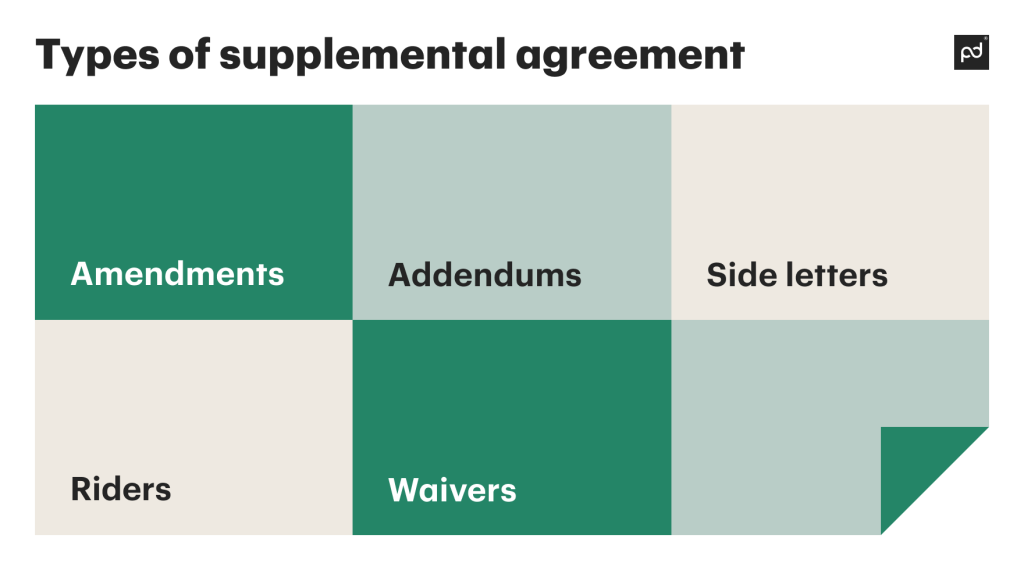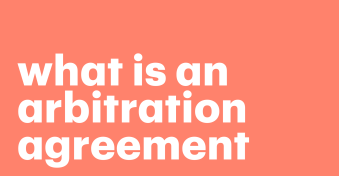Have you ever stumbled upon the term ‘supplemental agreement’ and wondered if it was some kind of secret weapon in the realm of contracts?
Well, fasten your seatbelts because we’re about to embark on a thrilling adventure to unravel their mysteries, the advantages and downsides, and the different types of supplemental agreements that are out there.
We’ll even witness a real-life example in action.
Key takeaways:
- Supplemental agreements are used to modify clauses, address new conditions or clarify ambiguous language within contracts.
- They are effective tools when it comes to risk management and compliance.
- They are flexible, customizable and ensure efficient communication.
- They come in several forms such as waivers and addendums.
- Use solid contract management software to stay on top of every contractual alteration.
What exactly is a supplemental agreement?
A supplemental agreement is a document created to modify or add provisions to an existing agreement.
It serves as an amendment or addendum to the original agreement, outlining the specific changes or additions agreed upon by the parties involved.
Put another way, a supplemental agreement is like a trusty sidekick that joins forces with the primary agreement to enhance, modify, or expand its powers.
Think of it as an add-on, extension, or even a mini-contract that swoops in when you need to make changes, clarifications, or additions to your existing agreement.
It’s the ultimate tool to keep contractual relationships flexible and adaptable in the face of unforeseen circumstances or evolving needs.
Now, you might wonder, “How exactly does a supplemental agreement relate to the primary agreement?”
Imagine your primary agreement is like the foundation of your contract, establishing the core terms and obligations.
However, life is unpredictable, and situations may arise where you need to tweak or fine-tune its terms.
Enter the supplemental agreement. It steps onto the stage to modify specific clauses, address new conditions, or clarify ambiguous language within the primary agreement.
It’s like a contract upgrade, ensuring your agreement remains relevant and aligned with your business or personal dealings’ changing tides.
Here’s the best part: a supplemental agreement isn’t just some abstract concept.
It’s a tangible document that puts your modifications into writing, providing clear evidence of the changes made to your original agreement.
So, no more confusion or misunderstandings.
With a supplemental agreement in hand, you’re equipped with a powerful tool to navigate the twists and turns of the contractual realm.
The significance of a supplemental agreement
Now, let’s uncover its significance in the world of contracts.
Brace yourself because it’s time to discover why these contracts are crucial.
First and foremost, supplemental agreements are about keeping the peace.
They are powerful tools for maintaining harmony and effective communication between the parties involved in a contract.
When unexpected circumstances arise or changes become necessary, a supplemental agreement swoops in to save the day, ensuring everyone is on the same page and preventing potential disputes.
These agreements are mediators, enabling parties to modify, clarify, or extend the terms of their primary agreement without resorting to a complete overhaul.
This allows for agile adjustments tailored to specific situations, whether adding new obligations, adjusting timelines, or incorporating additional deliverables.
They also shine when it comes to risk management and compliance.
By addressing unforeseen situations with a supplemental agreement, you can mitigate potential risks and protect yourself from the unknown.
It’s like having a secret shield that safeguards against the unexpected twists and turns of business or personal dealings.
Furthermore, supplemental agreements provide flexibility that primary agreements alone might not achieve.
They allow you to adapt your contracts to changing circumstances, market fluctuations, and evolving business needs, all while keeping the underlying principles intact.
This flexibility is essential in today’s fast-paced world, where agility and adaptability are key to staying ahead of the curve.
Advantages and downsides of supplemental agreements
As with any powerful tool, supplemental agreements offer a range of benefits, but it’s essential to also be aware of their potential drawbacks.
The advantages
Flexibility
Supplemental agreements are the champions of adaptability.
They empower you to make specific adjustments to your primary agreement to accommodate changing circumstances or unforeseen situations.
Need to extend a deadline, modify a payment schedule, or introduce new terms?
They allow you to do just that, providing the flexibility to keep contracts in line with your evolving needs.
Customization
Every contract is unique, and supplemental agreements enable you to tailor them to your specific requirements.
You can address particular concerns, add specialized provisions, or clarify ambiguous language to ensure the contract aligns perfectly with your needs.
It’s like having a contract tailor who can stitch in those extra details to make it a perfect fit.
Efficient communication
If the parties involved in a contract wish to modify terms, a supplemental agreement becomes a channel for effective communication.
It ensures all parties are aware of the changes and clearly understand their implications.
Documenting modifications in writing minimizes the chances of miscommunication or misunderstandings, promoting harmonious contract management.
The downsides
Increased complexity
As we delve into the realm of supplemental agreements, we must acknowledge that with power comes responsibility.
The more amendments or additions you make, the more complex the agreement becomes.
So, exercising caution and ensuring the supplemental agreement doesn’t create confusion or conflicting terms is crucial.
Careful drafting, review, and legal guidance are essential to navigate this potential pitfall.
Time and effort
Let’s face it: crafting and negotiating a supplemental agreement takes time and effort.
It involves additional rounds of discussions, document preparation, and potentially even legal consultations.
It’s crucial to weigh the benefits against the resources required, especially for minor modifications.
However, when faced with significant changes or critical updates, the investment of time and effort is well worth it.
Potential ambiguity
While a supplemental agreement is intended to clarify and modify the primary agreement, there is a risk of inadvertently introducing ambiguity.
It’s vital to ensure the language used in the supplemental agreement is clear, concise, and aligns with the primary agreement.
Ambiguity can lead to confusion and potential disputes down the line, so vigilance in drafting and reviewing is key.
Types of supplemental agreement
As we continue our journey through the world of supplemental agreements, it’s time to unveil the diverse types that exist.
Brace yourselves because there’s a whole array of contract companions waiting to assist you in different scenarios.
Let’s dive in and discover the types of supplemental agreements at your disposal.

1. Amendments
These are perhaps the most commonly encountered supplemental agreements.
Amendments serve as official modifications to the terms and conditions of the primary agreement.
They can add, delete, or alter specific provisions to ensure the agreement stays up-to-date and aligned with changing circumstances.
2. Addendums
Similar to amendments, addendums are supplemental agreements that add new provisions or information to the primary agreement.
They provide an opportunity to introduce additional terms that weren’t initially addressed but are deemed necessary.
Think of addendums as the “appendix” of your contract, adding relevant details without disturbing the core.
3. Side letters
Side letters are supplemental agreements that typically accompany the primary agreement.
They’re often used in business transactions and provide additional terms or specific arrangements that aren’t included in the primary agreement.
Side letters serve as a means to address unique circumstances or negotiations between specific parties involved in the contract.
4. Riders
Riders are supplemental agreements specifically used in the realm of legal documents, such as contracts or leases.
They function as additional sections or clauses attached to the primary agreement.
Riders allow for specific modifications or expansions to be made without altering the core provisions, streamlining the process of adjusting contractual terms.
5. Waivers
In some cases, parties may want to waive certain rights or obligations outlined in the primary agreement.
A waiver is a supplemental agreement that releases one or more parties from fulfilling or enforcing specific provisions of the primary agreement.
It provides a formal acknowledgment and agreement between the parties involved that certain terms will not be enforced as originally stipulated.
Comparison between supplemental agreement vs. primary agreement
Let’s now embark on an exciting comparison between supplemental agreements and their primary agreement counterparts.
By understanding the distinctions between these contracts, you’ll gain a deeper understanding of their roles and significance.
Scope and focus
Primary agreements
Primary agreements are the foundational contracts that establish the core terms, rights, and obligations between parties.
They outline the contractual relationship’s main purpose, subject matter, and general framework.
Supplemental agreements
On the other hand, supplemental agreements are companions to primary agreements, focusing on specific modifications, additions, or clarifications within the existing contractual framework.
They zoom in on particular aspects or unforeseen circumstances that require adjustments or customization.
Legal effect
Primary agreements
Primary agreements are the primary source of legal rights and obligations for the parties involved.
They establish the baseline for contractual enforcement and legal remedies.
Supplemental agreements
While supplemental agreements derive their legal effect from the primary agreement, they possess their own independent legal significance.
They modify, extend, or clarify the terms of the primary agreement, adding a layer of enforceable obligations.
Enforceability
Primary agreements
Primary agreements typically govern the overarching contractual relationship and are enforceable as standalone documents.
Supplemental agreements
Supplemental agreements, while connected to the primary agreement, are enforceable within the context of the primary agreement.
They work in conjunction with the primary agreement and derive their enforceability from it.
Modifications and customizations
Primary agreements
Primary agreements are usually comprehensive and cover various terms and conditions.
However, once executed, making changes or modifications can be more complex and may require mutual agreement and formal amendments.
Supplemental agreements
Supplemental agreements excel at modifying, adding, or clarifying specific provisions within the primary agreement.
They offer a more nimble and focused approach to addressing evolving needs or unforeseen circumstances without requiring a complete overhaul of the primary agreement.
Supplemental agreement example
At this point, it’s time to bring the power of supplemental agreements to life with a practical example to illustrate their real-world impact.
Let’s say you’re a small business owner who leased a commercial space for your thriving bookstore.
The original lease agreement was signed a few years ago, but as your business has expanded, you find yourself in need of additional space to accommodate your growing inventory.
Instead of searching for a new location and going through the hassle of relocating, you decide to explore a supplemental agreement.
You approach your landlord with a proposal to modify the existing lease. Here’s how the process unfolds.
Negotiation
You and your landlord discuss the proposed modifications.
You aim to extend the lease term, increase the square footage of the leased space, and adjust the rental amount to reflect the expanded area.
Drafting the supplemental agreement
With the terms agreed upon, a supplemental agreement is drafted to capture the modifications.
It outlines the specific changes to the lease agreement, including the extended lease term, revised square footage, and the corresponding adjustments to the rental amount.
Review and execution
Both parties carefully review the supplemental agreement to ensure it accurately reflects their intentions and aligns with the original lease agreement.
Once satisfied, you and your landlord sign the supplemental agreement, acknowledging the modifications and making the lease addendum legally binding.
Legal compliance
The supplemental agreement ensures that all modifications comply with legal requirements and are enforceable within the context of the primary lease agreement.
It provides a clear record of the agreed-upon changes, minimizing the chances of disputes or misunderstandings in the future.
By opting for a supplemental agreement, you successfully navigate the process of expanding your leased space without the need for a complete renegotiation or searching for a new location.
The supplemental agreement bridges your evolving needs and the existing lease agreement, offering the flexibility and customization required to accommodate your business growth.
PandaDoc’s automated agreement execution ensures legal compliance and risk mitigation
In the realm of supplemental agreements, PandaDoc’s automated agreement execution tool stands as a game-changer.
With its streamlined workflow, compliance features, and risk mitigation capabilities, it revolutionizes contract management.
Say goodbye to manual processes and hello to efficiency.
PandaDoc’s platform enables seamless creation, customization, and management of supplemental agreements.
It also ensures compliance and security through encryption and authentication. Collaboration and version control becomes effortless, while automation simplifies the approval process.
You can even gain insights via analytics to optimize your contract strategies.
With PandaDoc as your sidekick, navigating the contract landscape is a breeze.
Embrace the flexibility and customization of supplemental agreements while PandaDoc’s automation ensures legal compliance and mitigates risks.
Unleash the full potential of your contracts and elevate your contract management to new heights.
Disclaimer
PandaDoc is not a law firm, or a substitute for an attorney or law firm. This page is not intended to and does not provide legal advice. Should you have legal questions on the validity of e-signatures or digital signatures and the enforceability thereof, please consult with an attorney or law firm. Use of PandaDocs services are governed by our Terms of Use and Privacy Policy.


